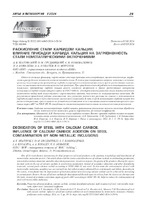| dc.contributor.author | Шатовский, А. В. | ru |
| dc.contributor.author | Грудницкий, О. М. | ru |
| dc.contributor.author | Коноваленко, С. В. | ru |
| dc.contributor.author | Ковалева, И. А. | ru |
| dc.contributor.author | Ковалев, А. А. | ru |
| dc.contributor.author | Морозов, В. О. | ru |
| dc.coverage.spatial | Минск | ru |
| dc.date.accessioned | 2024-09-18T07:09:48Z | |
| dc.date.available | 2024-09-18T07:09:48Z | |
| dc.date.issued | 2024 | |
| dc.identifier.citation | Раскисление стали карбидом кальция. Влияние присадки карбида кальция на загрязненность стали неметаллическими включениями = Deoxidation of steel with calcium carbide. Influence of calcium carbide addition on steel contamination by non-metallic inclusions / А. В. Шатовский [и др.] // Литье и металлургия. – 2024. – № 3. – С. 29-34. | ru |
| dc.identifier.uri | https://rep.bntu.by/handle/data/149623 | |
| dc.description.abstract | Одним из основных факторов, определяющих конечные свойства
металлопродукции, является количество, морфология и распределение неметаллических включений в стали. В статье рассматриваются вопросы, связанные с использованием в сталеплавильном производстве карбида кальция взамен алюминия вторичного и других раскисляющих материалов с целью повышения качества выпускаемой продукции. При проведении опытной работы по использованию в сталеплавильном производстве карбида кальция взамен алюминия вторичного и других раскисляющих материалов
использовался карбид кальция второго сорта по ГОСТ 1460-81. Для определения загрязнения стали неметаллическими
включениями отбор проб осуществлялся с горячекатаного проката, полученного из непрерывнолитых заготовок. По
результатам проведенной работы установленно, что улучшение раскисления расплава на плавках с использованием
карбида кальция может быть достигнуто увеличением его расхода. В свою очередь использование карбида кальция для
раскисления расплава, при его выпуске из дуговой сталеплавильной печи в стальковш взамен алюминия вторичного чушкового марки АВ87 по ГОСТ 295-98 способствует снижению загрязненности стали неметаллическими включениями. | ru |
| dc.language.iso | ru | ru |
| dc.publisher | БНТУ | ru |
| dc.title | Раскисление стали карбидом кальция. Влияние присадки карбида кальция на загрязненность стали неметаллическими включениями | ru |
| dc.title.alternative | Deoxidation of steel with calcium carbide. Influence of calcium carbide addition on steel contamination by non-metallic inclusions | ru |
| dc.type | Article | ru |
| dc.identifier.doi | 10.21122/1683-6065-2024-2-29-34 | |
| local.description.annotation | One of the main factors determining the final properties of metal products is the quantity, morphology and distribution of
non-metallic inclusions in steel. The article deals with the issues related to the use of calcium carbide in steelmaking production,
instead of secondary aluminum and other deoxidizing materials, in order to improve the quality of the products. During the experimental
work on the use of calcium carbide in steelmaking production, instead of secondary aluminum and other deoxidizing
materials, second grade calcium carbide according to GOST 1460–81 was used. To determine the contamination of steel with
non-metallic inclusions, sampling was carried out from hot-rolled products obtained from continuously cast billets. According to
the results, it was found that the improvement of melt deoxidation in melts using calcium carbide can be achieved by increasing
its consumption. In turn, the use of calcium carbide for deoxidation of the melt upon its release from the electric arc furnace into
the ladle, instead of secondary aluminum ingots of grade AB87 according to GOST 295–98, helps to reduce the contamination of
steel with non-metallic inclusions. | ru |

